Working with AutoComplete in Windows Forms AutoComplete
6 Oct 20229 minutes to read
This section explains how to work with various options in the AutoComplete component.
Setting AutoComplete modes
The AutoComplete component provides the auto-complete support to the editor control based on the input text. It can be done using the SetAutoComplete method.
The different types of AutoComplete modes are as follows.
| AutoComplete modes | Description |
|---|---|
| AutoSuggest |
Suggests and displays a list of probable matches in the drop-down list by setting the AutoCompleteMode to AutoSuggest.
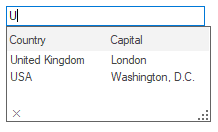
|
| AutoAppend |
Appends the most appropriate match for the current content in the editor control automatically.

|
| Both |
Activates both AutoAppend and AutoSuggest modes of auto completion for the editor control.
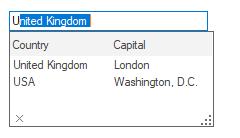
|
| Disabled |
Disables auto complete support for the editor control.

|
| MultiSuggest |
Checks whether the beginning of items in the list pop up matches with user input string. Then matched cases from various columns are shown as suggestions. The MultiSuggest mode is an extended mode of AutoSuggest.
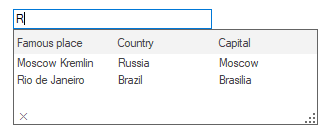
|
| MultiSuggestExtend |
Checks whether the entered character or sequence of character is present in any part of the word in list popup item. Then matched cases from various columns are shown as suggestions.
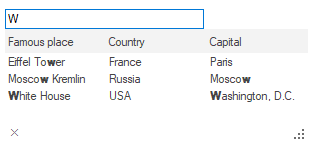
|
The following code snippet shows how to update the AutoComplete modes.
autoComplete1.SetAutoComplete(this.textBox1, Syncfusion.Windows.Forms.Tools.AutoCompleteModes.MultiSuggestExtended);autoComplete1.SetAutoComplete(Me.textBox1, Syncfusion.Windows.Forms.Tools.AutoCompleteModes.MultiSuggestExtended)NOTE
The values are filtered from the column which is set as matching column for auto complete. By default, the MatchingColumn value is
truefor the first column of binding source.
A sample that demonstrates the AutoComplete mode is available here
Case sensitivity
Specifies whether to ignore case for string comparison. It can be enabled by setting the CaseSensitive property to true. The default value of this property is true.
autoComplete1.CaseSensitive = true;autoComplete1.CaseSensitive = TrueMatch mode
The MatchMode property specifies the mode where the most appropriate match for the current content in the editor control is filled in the AutoComplete history list. The default value is Automatic.
The following code snippet implements column configuration.
this.autoComplete1.MatchMode = AutoCompleteMatchModes.Automatic;Me.autoComplete1.MatchMode = AutoCompleteMatchModes.AutomaticMatching column
The MatchingColumn indicates the represented column to be treated as matching column. The default value of this property is true for 0th index column.
Refresh column before setting MatchingColumn using the RefreshColumns method.
this.autoComplete1.RefreshColumns();
this.autoComplete1.Columns[1].MatchingColumn = true;Me.autoComplete1.RefreshColumns()
Me.autoComplete1.Columns(1).MatchingColumn = trueSorting items
Specifies whether sorting needs to be performed in the items present in the AutoComplete popup. It can be done by setting the AutoSortList property to true. The default value of this property is true.
autoComplete1.AutoSortList = true;autoComplete1.AutoSortList = TrueNOTE
The items are sorted on the basis of the column whose MatchingColumn are set to
true.
Handling duplicate values
The duplicate values can be used in AutoComplete data source by setting the EnableDuplicateValues property to true.
autoComplete1.EnableDuplicateValues = true;autoComplete1.EnableDuplicateValues = TrueMaintaining history of user inputs
Adding items to history list
The current input text in the editor control can be added to the history list at run time when the Enter key is pressed. This support can be enabled by setting the AutoAddItem property to true. The default value of this property is false.
autoComplete1.AutoAddItem = true;autoComplete1.AutoAddItem = TrueDeleting items from history list
The current selected item can be removed from auto complete popup when the Delete key is pressed at run time. This support can be enabled by setting the AllowListDelete property to true.
autoComplete1.AllowListDelete = true;autoComplete1.AllowListDelete = TrueDeleting history
The history items persisted by the AutoComplete component can be deleted by invoking the ResetHistory method. The entire history list in the AutoComplete popup will be deleted.
autoComplete1.ResetHistory();autoComplete1.ResetHistory();Setting maximum number of suggestions
You can limit the number of suggestions need to be displayed in the AutoComplete popup using the MaxNumberofSuggestion property.
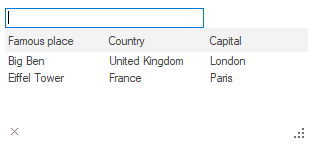
autoComplete1.MaxNumberofSuggestion = 2;autoComplete1.MaxNumberofSuggestion = 2Integration with MS ComboBox
If MS ComboBox is used as editor control, the Combobox dropdown can be suppressed and overridden by the AutoComplete component using the OverrideCombo property.

A sample that demonstrates the above feature is available here
Integration with RichTextBox control
The auto-complete functionality can be added to the RichTextBox control. The following steps are used to integrate the RichTextBox with the AutoComplete component:
-
Implement the
IEditControlsEmbedinterface in a CustomRichTextBox class that enables the AutoComplete functionality for the RichTextBox control.public class CustomRichTextBox : System.Windows.Forms.RichTextBox, IEditControlsEmbed { // Returns the active RichTextBox control. public Control GetActiveEditControl(IEditControlsEmbedListener listener) { return (Control)this; } }Public Class CustomRichTextBox Inherits System.Windows.Forms.RichTextBox Implements IEditControlsEmbed ' Returns the active RichTextBox control. Public Function GetActiveEditControl(ByVal listener As IEditControlsEmbedListener) As Control Return CType(Me, Control) End Function End Class -
Create an instance for the CustomRichTextBox class and the AutoComplete component. Then, use the SetAutoComplete method of AutoComplete component to enable auto-complete support for the RichTextBox control.
Syncfusion.Windows.Forms.Tools.AutoComplete autoComplete1= new Syncfusion.Windows.Forms.Tools.AutoComplete(); CustomRichTextBox richTextBox1= new CustomRichTextBox(); autoComplete1.SetAutoComplete(richTextBox1, Syncfusion.Windows.Forms.Tools.AutoCompleteModes.AutoSuggest);Dim autoComplete1 As Syncfusion.Windows.Forms.Tools.AutoComplete = New Syncfusion.Windows.Forms.Tools.AutoComplete Dim richTextBox1 As CustomRichTextBox = New CustomRichTextBox autoComplete1.SetAutoComplete(richTextBox1, AutoCompleteModes.AutoSuggest)

A sample that demonstrates the integration with RichTextBox control is available here
Opening the AutoComplete popup programmatically
The AutoComplete popup can be shown programmatically using the AutoCompletePopup method.
autoComplete1.AutoCompletePopup.ParentControl = textBox1;
this.autoComplete1.AutoCompletePopup.ShowPopup(Point.Empty);autoComplete1.AutoCompletePopup.ParentControl = textBox1
autoComplete1.AutoCompletePopup.ShowPopup(Point.Empty)